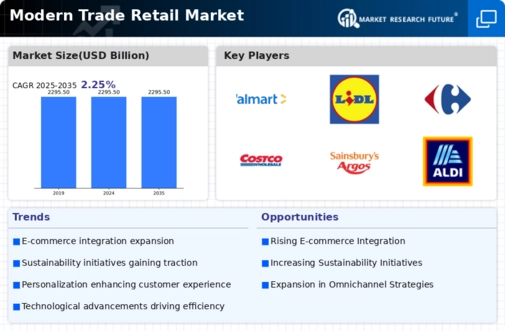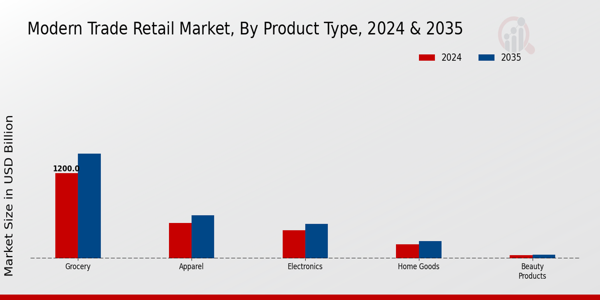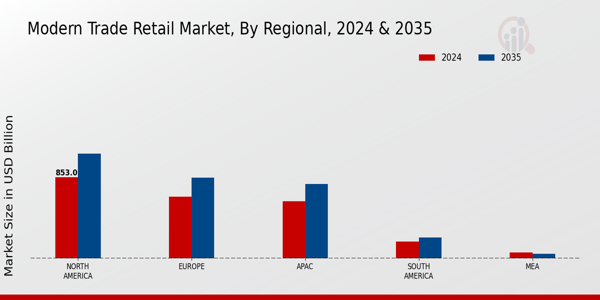-
'TABLE OF CONTENTS
-
EXECUTIVE SUMMARY
-
Market Overview
-
Key Findings
-
Market Segmentation
-
Competitive Landscape
-
Challenges and Opportunities
-
Future Outlook
-
MARKET INTRODUCTION
-
Definition
-
Scope of the study
- Research Objective
- Assumption
- Limitations
-
RESEARCH METHODOLOGY
-
Overview
-
Data Mining
-
Secondary Research
-
Primary Research
-
Primary Interviews and Information Gathering Process
-
Breakdown of Primary
-
Respondents
-
Forecasting Model
-
Market Size Estimation
-
Bottom-Up Approach
-
Top-Down Approach
-
Data Triangulation
-
Validation
-
MARKET DYNAMICS
-
Overview
-
Drivers
-
Restraints
-
Opportunities
-
MARKET FACTOR ANALYSIS
-
Value chain Analysis
-
Porter''s Five Forces
-
Analysis
-
Bargaining Power of Suppliers
- Bargaining Power
-
of Buyers
-
Threat of New Entrants
- Threat of Substitutes
- Intensity of Rivalry
-
COVID-19 Impact Analysis
-
Market Impact Analysis
-
Regional Impact
- Opportunity and
-
Threat Analysis
-
MODERN TRADE RETAIL MARKET, BY PRODUCT
-
TYPE (USD BILLION)
-
Grocery
-
Apparel
-
Electronics
-
Home Goods
-
Beauty Products
-
MODERN TRADE RETAIL MARKET,
-
BY STORE FORMAT (USD BILLION)
-
Hypermarkets
-
Supermarkets
-
Convenience Stores
-
Department Stores
-
Discount Stores
-
MODERN TRADE RETAIL MARKET, BY CONSUMER DEMOGRAPHICS (USD BILLION)
-
Millennials
-
Generation X
-
Baby Boomers
-
Generation
-
Z
-
MODERN TRADE RETAIL MARKET, BY SHOPPING CHANNEL (USD BILLION)
-
Online
-
In-Store
-
Mobile Commerce
-
MODERN TRADE RETAIL
-
MARKET, BY REGIONAL (USD BILLION)
-
North America
- US
- Canada
-
Europe
- Germany
- UK
-
France
-
Russia
- Italy
- Spain
-
Rest of Europe
-
APAC
- China
- India
-
Japan
-
South Korea
- Malaysia
- Thailand
- Indonesia
- Rest of APAC
-
South America
-
Brazil
-
Mexico
- Argentina
- Rest of South
-
America
-
MEA
- GCC Countries
- South Africa
- Rest of MEA
-
COMPETITIVE LANDSCAPE
-
Overview
-
Competitive Analysis
-
Market share Analysis
-
Major Growth Strategy in the Modern Trade Retail Market
-
Competitive
-
Benchmarking
-
Leading Players in Terms of Number of Developments in the
-
Modern Trade Retail Market
-
Key developments and growth strategies
- New Product Launch/Service Deployment
- Merger & Acquisitions
- Joint Ventures
-
Major Players Financial Matrix
-
Sales and Operating Income
-
Major Players R&D Expenditure. 2023
-
COMPANY PROFILES
-
Walmart
- Financial Overview
- Products Offered
- Key Developments
- SWOT
-
Analysis
-
Key Strategies
-
Lidl
- Financial Overview
- Products Offered
- Key Developments
- SWOT
-
Analysis
-
Key Strategies
-
Carrefour
- Financial
-
Overview
-
Products Offered
- Key Developments
-
SWOT Analysis
-
Key Strategies
-
Schwarz Group
-
Financial Overview
-
Products Offered
- Key Developments
- SWOT Analysis
- Key Strategies
-
Costco
- Financial Overview
- Products Offered
- Key Developments
- SWOT Analysis
- Key Strategies
-
Sainsbury''s
- Financial Overview
- Products Offered
- Key
-
Developments
-
SWOT Analysis
- Key Strategies
-
Aldi
-
Financial Overview
- Products Offered
-
Key Developments
-
SWOT Analysis
- Key Strategies
-
Walgreens Boots Alliance
-
Financial Overview
- Products
-
Offered
-
Key Developments
- SWOT Analysis
-
Key Strategies
-
Ahold Delhaize
- Financial Overview
-
Products Offered
-
Key Developments
- SWOT Analysis
- Key Strategies
-
Amazon
- Financial Overview
- Products Offered
- Key Developments
- SWOT
-
Analysis
-
Key Strategies
-
Tesco
- Financial
-
Overview
-
Products Offered
- Key Developments
-
SWOT Analysis
-
Key Strategies
-
7Eleven
-
Financial Overview
-
Products Offered
- Key Developments
- SWOT Analysis
- Key Strategies
-
Target
- Financial Overview
- Products Offered
- Key
-
Developments
-
SWOT Analysis
- Key Strategies
-
Metro AG
-
Financial Overview
- Products Offered
-
Key Developments
-
SWOT Analysis
- Key Strategies
-
Alibaba Group
- Financial Overview
- Products
-
Offered
-
Key Developments
- SWOT Analysis
-
Key Strategies
-
APPENDIX
-
References
-
Related Reports
-
AMERICA MODERN TRADE RETAIL MARKET SIZE ESTIMATES & FORECAST, BY PRODUCT TYPE,
-
2035 (USD BILLIONS)
-
SIZE ESTIMATES & FORECAST, BY STORE FORMAT, 2019-2035 (USD BILLIONS)
-
NORTH AMERICA MODERN TRADE RETAIL MARKET SIZE ESTIMATES & FORECAST, BY CONSUMER
-
DEMOGRAPHICS, 2019-2035 (USD BILLIONS)
-
RETAIL MARKET SIZE ESTIMATES & FORECAST, BY SHOPPING CHANNEL, 2019-2035 (USD
-
BILLIONS)
-
& FORECAST, BY REGIONAL, 2019-2035 (USD BILLIONS)
-
RETAIL MARKET SIZE ESTIMATES & FORECAST, BY PRODUCT TYPE, 2019-2035 (USD BILLIONS)
-
FORMAT, 2019-2035 (USD BILLIONS)
-
ESTIMATES & FORECAST, BY CONSUMER DEMOGRAPHICS, 2019-2035 (USD BILLIONS)
-
CHANNEL, 2019-2035 (USD BILLIONS)
-
SIZE ESTIMATES & FORECAST, BY REGIONAL, 2019-2035 (USD BILLIONS)
-
CANADA MODERN TRADE RETAIL MARKET SIZE ESTIMATES & FORECAST, BY PRODUCT
-
TYPE, 2019-2035 (USD BILLIONS)
-
SIZE ESTIMATES & FORECAST, BY STORE FORMAT, 2019-2035 (USD BILLIONS)
-
CANADA MODERN TRADE RETAIL MARKET SIZE ESTIMATES & FORECAST, BY CONSUMER
-
DEMOGRAPHICS, 2019-2035 (USD BILLIONS)
-
MARKET SIZE ESTIMATES & FORECAST, BY SHOPPING CHANNEL, 2019-2035 (USD BILLIONS)
-
BY REGIONAL, 2019-2035 (USD BILLIONS)
-
MARKET SIZE ESTIMATES & FORECAST, BY PRODUCT TYPE, 2019-2035 (USD BILLIONS)
-
BY STORE FORMAT, 2019-2035 (USD BILLIONS)
-
MARKET SIZE ESTIMATES & FORECAST, BY CONSUMER DEMOGRAPHICS, 2019-2035 (USD BILLIONS)
-
BY SHOPPING CHANNEL, 2019-2035 (USD BILLIONS)
-
RETAIL MARKET SIZE ESTIMATES & FORECAST, BY REGIONAL, 2019-2035 (USD BILLIONS)
-
BY PRODUCT TYPE, 2019-2035 (USD BILLIONS)
-
MARKET SIZE ESTIMATES & FORECAST, BY STORE FORMAT, 2019-2035 (USD BILLIONS)
-
BY CONSUMER DEMOGRAPHICS, 2019-2035 (USD BILLIONS)
-
TRADE RETAIL MARKET SIZE ESTIMATES & FORECAST, BY SHOPPING CHANNEL, 2019-2035
-
(USD BILLIONS)
-
& FORECAST, BY REGIONAL, 2019-2035 (USD BILLIONS)
-
TRADE RETAIL MARKET SIZE ESTIMATES & FORECAST, BY PRODUCT TYPE, 2019-2035 (USD
-
BILLIONS)
-
BY STORE FORMAT, 2019-2035 (USD BILLIONS)
-
MARKET SIZE ESTIMATES & FORECAST, BY CONSUMER DEMOGRAPHICS, 2019-2035 (USD BILLIONS)
-
SHOPPING CHANNEL, 2019-2035 (USD BILLIONS)
-
MARKET SIZE ESTIMATES & FORECAST, BY REGIONAL, 2019-2035 (USD BILLIONS)
-
PRODUCT TYPE, 2019-2035 (USD BILLIONS)
-
MARKET SIZE ESTIMATES & FORECAST, BY STORE FORMAT, 2019-2035 (USD BILLIONS)
-
BY CONSUMER DEMOGRAPHICS, 2019-2035 (USD BILLIONS)
-
TRADE RETAIL MARKET SIZE ESTIMATES & FORECAST, BY SHOPPING CHANNEL, 2019-2035
-
(USD BILLIONS)
-
& FORECAST, BY REGIONAL, 2019-2035 (USD BILLIONS)
-
TRADE RETAIL MARKET SIZE ESTIMATES & FORECAST, BY PRODUCT TYPE, 2019-2035 (USD
-
BILLIONS)
-
FORECAST, BY STORE FORMAT, 2019-2035 (USD BILLIONS)
-
TRADE RETAIL MARKET SIZE ESTIMATES & FORECAST, BY CONSUMER DEMOGRAPHICS, 2019-2035
-
(USD BILLIONS)
-
& FORECAST, BY SHOPPING CHANNEL, 2019-2035 (USD BILLIONS)
-
MODERN TRADE RETAIL MARKET SIZE ESTIMATES & FORECAST, BY REGIONAL, 2019-2035
-
(USD BILLIONS)
-
FORECAST, BY PRODUCT TYPE, 2019-2035 (USD BILLIONS)
-
TRADE RETAIL MARKET SIZE ESTIMATES & FORECAST, BY STORE FORMAT, 2019-2035 (USD
-
BILLIONS)
-
FORECAST, BY CONSUMER DEMOGRAPHICS, 2019-2035 (USD BILLIONS)
-
MODERN TRADE RETAIL MARKET SIZE ESTIMATES & FORECAST, BY SHOPPING CHANNEL, 2019-2035
-
(USD BILLIONS)
-
FORECAST, BY REGIONAL, 2019-2035 (USD BILLIONS)
-
RETAIL MARKET SIZE ESTIMATES & FORECAST, BY PRODUCT TYPE, 2019-2035 (USD BILLIONS)
-
BY STORE FORMAT, 2019-2035 (USD BILLIONS)
-
MARKET SIZE ESTIMATES & FORECAST, BY CONSUMER DEMOGRAPHICS, 2019-2035 (USD BILLIONS)
-
BY SHOPPING CHANNEL, 2019-2035 (USD BILLIONS)
-
RETAIL MARKET SIZE ESTIMATES & FORECAST, BY REGIONAL, 2019-2035 (USD BILLIONS)
-
BY PRODUCT TYPE, 2019-2035 (USD BILLIONS)
-
TRADE RETAIL MARKET SIZE ESTIMATES & FORECAST, BY STORE FORMAT, 2019-2035 (USD
-
BILLIONS)
-
& FORECAST, BY CONSUMER DEMOGRAPHICS, 2019-2035 (USD BILLIONS)
-
REST OF EUROPE MODERN TRADE RETAIL MARKET SIZE ESTIMATES & FORECAST, BY SHOPPING
-
CHANNEL, 2019-2035 (USD BILLIONS)
-
MARKET SIZE ESTIMATES & FORECAST, BY REGIONAL, 2019-2035 (USD BILLIONS)
-
TYPE, 2019-2035 (USD BILLIONS)
-
ESTIMATES & FORECAST, BY STORE FORMAT, 2019-2035 (USD BILLIONS)
-
APAC MODERN TRADE RETAIL MARKET SIZE ESTIMATES & FORECAST, BY CONSUMER DEMOGRAPHICS,
-
2035 (USD BILLIONS)
-
& FORECAST, BY SHOPPING CHANNEL, 2019-2035 (USD BILLIONS)
-
MODERN TRADE RETAIL MARKET SIZE ESTIMATES & FORECAST, BY REGIONAL, 2019-2035
-
(USD BILLIONS)
-
FORECAST, BY PRODUCT TYPE, 2019-2035 (USD BILLIONS)
-
TRADE RETAIL MARKET SIZE ESTIMATES & FORECAST, BY STORE FORMAT, 2019-2035 (USD
-
BILLIONS)
-
FORECAST, BY CONSUMER DEMOGRAPHICS, 2019-2035 (USD BILLIONS)
-
MODERN TRADE RETAIL MARKET SIZE ESTIMATES & FORECAST, BY SHOPPING CHANNEL, 2019-2035
-
(USD BILLIONS)
-
FORECAST, BY REGIONAL, 2019-2035 (USD BILLIONS)
-
RETAIL MARKET SIZE ESTIMATES & FORECAST, BY PRODUCT TYPE, 2019-2035 (USD BILLIONS)
-
BY STORE FORMAT, 2019-2035 (USD BILLIONS)
-
MARKET SIZE ESTIMATES & FORECAST, BY CONSUMER DEMOGRAPHICS, 2019-2035 (USD BILLIONS)
-
BY SHOPPING CHANNEL, 2019-2035 (USD BILLIONS)
-
RETAIL MARKET SIZE ESTIMATES & FORECAST, BY REGIONAL, 2019-2035 (USD BILLIONS)
-
BY PRODUCT TYPE, 2019-2035 (USD BILLIONS)
-
MARKET SIZE ESTIMATES & FORECAST, BY STORE FORMAT, 2019-2035 (USD BILLIONS)
-
BY CONSUMER DEMOGRAPHICS, 2019-2035 (USD BILLIONS)
-
TRADE RETAIL MARKET SIZE ESTIMATES & FORECAST, BY SHOPPING CHANNEL, 2019-2035
-
(USD BILLIONS)
-
FORECAST, BY REGIONAL, 2019-2035 (USD BILLIONS)
-
TRADE RETAIL MARKET SIZE ESTIMATES & FORECAST, BY PRODUCT TYPE, 2019-2035 (USD
-
BILLIONS)
-
& FORECAST, BY STORE FORMAT, 2019-2035 (USD BILLIONS)
-
KOREA MODERN TRADE RETAIL MARKET SIZE ESTIMATES & FORECAST, BY CONSUMER DEMOGRAPHICS,
-
2035 (USD BILLIONS)
-
SIZE ESTIMATES & FORECAST, BY SHOPPING CHANNEL, 2019-2035 (USD BILLIONS)
-
BY REGIONAL, 2019-2035 (USD BILLIONS)
-
MARKET SIZE ESTIMATES & FORECAST, BY PRODUCT TYPE, 2019-2035 (USD BILLIONS)
-
BY STORE FORMAT, 2019-2035 (USD BILLIONS)
-
RETAIL MARKET SIZE ESTIMATES & FORECAST, BY CONSUMER DEMOGRAPHICS, 2019-2035
-
(USD BILLIONS)
-
& FORECAST, BY SHOPPING CHANNEL, 2019-2035 (USD BILLIONS)
-
MODERN TRADE RETAIL MARKET SIZE ESTIMATES & FORECAST, BY REGIONAL, 2019-2035
-
(USD BILLIONS)
-
& FORECAST, BY PRODUCT TYPE, 2019-2035 (USD BILLIONS)
-
MODERN TRADE RETAIL MARKET SIZE ESTIMATES & FORECAST, BY STORE FORMAT, 2019-2035
-
(USD BILLIONS)
-
& FORECAST, BY CONSUMER DEMOGRAPHICS, 2019-2035 (USD BILLIONS)
-
THAILAND MODERN TRADE RETAIL MARKET SIZE ESTIMATES & FORECAST, BY SHOPPING CHANNEL,
-
2035 (USD BILLIONS)
-
ESTIMATES & FORECAST, BY REGIONAL, 2019-2035 (USD BILLIONS)
-
INDONESIA MODERN TRADE RETAIL MARKET SIZE ESTIMATES & FORECAST, BY PRODUCT TYPE,
-
2035 (USD BILLIONS)
-
ESTIMATES & FORECAST, BY STORE FORMAT, 2019-2035 (USD BILLIONS)
-
INDONESIA MODERN TRADE RETAIL MARKET SIZE ESTIMATES & FORECAST, BY CONSUMER
-
DEMOGRAPHICS, 2019-2035 (USD BILLIONS)
-
MARKET SIZE ESTIMATES & FORECAST, BY SHOPPING CHANNEL, 2019-2035 (USD BILLIONS)
-
BY REGIONAL, 2019-2035 (USD BILLIONS)
-
RETAIL MARKET SIZE ESTIMATES & FORECAST, BY PRODUCT TYPE, 2019-2035 (USD BILLIONS)
-
BY STORE FORMAT, 2019-2035 (USD BILLIONS)
-
RETAIL MARKET SIZE ESTIMATES & FORECAST, BY CONSUMER DEMOGRAPHICS, 2019-2035
-
(USD BILLIONS)
-
& FORECAST, BY SHOPPING CHANNEL, 2019-2035 (USD BILLIONS)
-
OF APAC MODERN TRADE RETAIL MARKET SIZE ESTIMATES & FORECAST, BY REGIONAL, 2019-2035
-
(USD BILLIONS)
-
& FORECAST, BY PRODUCT TYPE, 2019-2035 (USD BILLIONS)
-
AMERICA MODERN TRADE RETAIL MARKET SIZE ESTIMATES & FORECAST, BY STORE FORMAT,
-
2035 (USD BILLIONS)
-
SIZE ESTIMATES & FORECAST, BY CONSUMER DEMOGRAPHICS, 2019-2035 (USD BILLIONS)
-
BY SHOPPING CHANNEL, 2019-2035 (USD BILLIONS)
-
TRADE RETAIL MARKET SIZE ESTIMATES & FORECAST, BY REGIONAL, 2019-2035 (USD BILLIONS)
-
BY PRODUCT TYPE, 2019-2035 (USD BILLIONS)
-
MARKET SIZE ESTIMATES & FORECAST, BY STORE FORMAT, 2019-2035 (USD BILLIONS)
-
BY CONSUMER DEMOGRAPHICS, 2019-2035 (USD BILLIONS)
-
TRADE RETAIL MARKET SIZE ESTIMATES & FORECAST, BY SHOPPING CHANNEL, 2019-2035
-
(USD BILLIONS)
-
& FORECAST, BY REGIONAL, 2019-2035 (USD BILLIONS)
-
TRADE RETAIL MARKET SIZE ESTIMATES & FORECAST, BY PRODUCT TYPE, 2019-2035 (USD
-
BILLIONS)
-
FORECAST, BY STORE FORMAT, 2019-2035 (USD BILLIONS)
-
TRADE RETAIL MARKET SIZE ESTIMATES & FORECAST, BY CONSUMER DEMOGRAPHICS, 2019-2035
-
(USD BILLIONS)
-
& FORECAST, BY SHOPPING CHANNEL, 2019-2035 (USD BILLIONS)
-
MODERN TRADE RETAIL MARKET SIZE ESTIMATES & FORECAST, BY REGIONAL, 2019-2035
-
(USD BILLIONS)
-
& FORECAST, BY PRODUCT TYPE, 2019-2035 (USD BILLIONS)
-
MODERN TRADE RETAIL MARKET SIZE ESTIMATES & FORECAST, BY STORE FORMAT, 2019-2035
-
(USD BILLIONS)
-
& FORECAST, BY CONSUMER DEMOGRAPHICS, 2019-2035 (USD BILLIONS)
-
ARGENTINA MODERN TRADE RETAIL MARKET SIZE ESTIMATES & FORECAST, BY SHOPPING
-
CHANNEL, 2019-2035 (USD BILLIONS)
-
MARKET SIZE ESTIMATES & FORECAST, BY REGIONAL, 2019-2035 (USD BILLIONS)
-
FORECAST, BY PRODUCT TYPE, 2019-2035 (USD BILLIONS)
-
AMERICA MODERN TRADE RETAIL MARKET SIZE ESTIMATES & FORECAST, BY STORE FORMAT,
-
2035 (USD BILLIONS)
-
MARKET SIZE ESTIMATES & FORECAST, BY CONSUMER DEMOGRAPHICS, 2019-2035 (USD BILLIONS)
-
& FORECAST, BY SHOPPING CHANNEL, 2019-2035 (USD BILLIONS)
-
OF SOUTH AMERICA MODERN TRADE RETAIL MARKET SIZE ESTIMATES & FORECAST, BY REGIONAL,
-
2035 (USD BILLIONS)
-
& FORECAST, BY PRODUCT TYPE, 2019-2035 (USD BILLIONS)
-
TRADE RETAIL MARKET SIZE ESTIMATES & FORECAST, BY STORE FORMAT, 2019-2035 (USD
-
BILLIONS)
-
BY CONSUMER DEMOGRAPHICS, 2019-2035 (USD BILLIONS)
-
RETAIL MARKET SIZE ESTIMATES & FORECAST, BY SHOPPING CHANNEL, 2019-2035 (USD
-
BILLIONS)
-
BY REGIONAL, 2019-2035 (USD BILLIONS)
-
RETAIL MARKET SIZE ESTIMATES & FORECAST, BY PRODUCT TYPE, 2019-2035 (USD BILLIONS)
-
BY STORE FORMAT, 2019-2035 (USD BILLIONS)
-
TRADE RETAIL MARKET SIZE ESTIMATES & FORECAST, BY CONSUMER DEMOGRAPHICS, 2019-2035
-
(USD BILLIONS)
-
& FORECAST, BY SHOPPING CHANNEL, 2019-2035 (USD BILLIONS)
-
COUNTRIES MODERN TRADE RETAIL MARKET SIZE ESTIMATES & FORECAST, BY REGIONAL,
-
2035 (USD BILLIONS)
-
SIZE ESTIMATES & FORECAST, BY PRODUCT TYPE, 2019-2035 (USD BILLIONS)
-
SOUTH AFRICA MODERN TRADE RETAIL MARKET SIZE ESTIMATES & FORECAST, BY STORE
-
FORMAT, 2019-2035 (USD BILLIONS)
-
MARKET SIZE ESTIMATES & FORECAST, BY CONSUMER DEMOGRAPHICS, 2019-2035 (USD BILLIONS)
-
BY SHOPPING CHANNEL, 2019-2035 (USD BILLIONS)
-
TRADE RETAIL MARKET SIZE ESTIMATES & FORECAST, BY REGIONAL, 2019-2035 (USD BILLIONS)
-
BY PRODUCT TYPE, 2019-2035 (USD BILLIONS)
-
RETAIL MARKET SIZE ESTIMATES & FORECAST, BY STORE FORMAT, 2019-2035 (USD BILLIONS)
-
BY CONSUMER DEMOGRAPHICS, 2019-2035 (USD BILLIONS)
-
MODERN TRADE RETAIL MARKET SIZE ESTIMATES & FORECAST, BY SHOPPING CHANNEL, 2019-2035
-
(USD BILLIONS)
-
& FORECAST, BY REGIONAL, 2019-2035 (USD BILLIONS)
-
DEVELOPMENT/APPROVAL
-
TRADE RETAIL MARKET ANALYSIS
-
BY PRODUCT TYPE
-
FORMAT
-
US MODERN TRADE RETAIL MARKET ANALYSIS BY REGIONAL
-
TRADE RETAIL MARKET ANALYSIS BY PRODUCT TYPE
-
RETAIL MARKET ANALYSIS BY STORE FORMAT
-
MARKET ANALYSIS BY CONSUMER DEMOGRAPHICS
-
MARKET ANALYSIS BY SHOPPING CHANNEL
-
MARKET ANALYSIS BY REGIONAL
-
GERMANY MODERN TRADE RETAIL MARKET ANALYSIS BY CONSUMER DEMOGRAPHICS
-
GERMANY MODERN TRADE RETAIL MARKET ANALYSIS BY SHOPPING CHANNEL
-
GERMANY MODERN TRADE RETAIL MARKET ANALYSIS BY REGIONAL
-
MODERN TRADE RETAIL MARKET ANALYSIS BY PRODUCT TYPE
-
RETAIL MARKET ANALYSIS BY STORE FORMAT
-
ANALYSIS BY CONSUMER DEMOGRAPHICS
-
ANALYSIS BY SHOPPING CHANNEL
-
BY REGIONAL
-
TYPE
-
RUSSIA MODERN TRADE RETAIL MARKET ANALYSIS BY PRODUCT TYPE
-
RUSSIA MODERN TRADE RETAIL MARKET ANALYSIS BY STORE FORMAT
-
MODERN TRADE RETAIL MARKET ANALYSIS BY CONSUMER DEMOGRAPHICS
-
MODERN TRADE RETAIL MARKET ANALYSIS BY SHOPPING CHANNEL
-
MODERN TRADE RETAIL MARKET ANALYSIS BY REGIONAL
-
RETAIL MARKET ANALYSIS BY PRODUCT TYPE
-
MARKET ANALYSIS BY STORE FORMAT
-
ANALYSIS BY CONSUMER DEMOGRAPHICS
-
ANALYSIS BY SHOPPING CHANNEL
-
BY REGIONAL
-
TYPE
-
REST OF EUROPE MODERN TRADE RETAIL MARKET ANALYSIS BY PRODUCT TYPE
-
REST OF EUROPE MODERN TRADE RETAIL MARKET ANALYSIS BY STORE FORMAT
-
REST OF EUROPE MODERN TRADE RETAIL MARKET ANALYSIS BY CONSUMER DEMOGRAPHICS
-
CHANNEL
-
MODERN TRADE RETAIL MARKET ANALYSIS BY PRODUCT TYPE
-
TRADE RETAIL MARKET ANALYSIS BY STORE FORMAT
-
RETAIL MARKET ANALYSIS BY CONSUMER DEMOGRAPHICS
-
RETAIL MARKET ANALYSIS BY SHOPPING CHANNEL
-
MARKET ANALYSIS BY REGIONAL
-
BY PRODUCT TYPE
-
FORMAT
-
JAPAN MODERN TRADE RETAIL MARKET ANALYSIS BY PRODUCT TYPE
-
MODERN TRADE RETAIL MARKET ANALYSIS BY STORE FORMAT
-
TRADE RETAIL MARKET ANALYSIS BY CONSUMER DEMOGRAPHICS
-
TRADE RETAIL MARKET ANALYSIS BY SHOPPING CHANNEL
-
RETAIL MARKET ANALYSIS BY REGIONAL
-
MARKET ANALYSIS BY PRODUCT TYPE
-
MARKET ANALYSIS BY STORE FORMAT
-
MARKET ANALYSIS BY CONSUMER DEMOGRAPHICS
-
RETAIL MARKET ANALYSIS BY SHOPPING CHANNEL
-
RETAIL MARKET ANALYSIS BY REGIONAL
-
MARKET ANALYSIS BY PRODUCT TYPE
-
ANALYSIS BY STORE FORMAT
-
BY CONSUMER DEMOGRAPHICS
-
BY SHOPPING CHANNEL
-
BY REGIONAL
-
TYPE
-
INDONESIA MODERN TRADE RETAIL MARKET ANALYSIS BY PRODUCT TYPE
-
INDONESIA MODERN TRADE RETAIL MARKET ANALYSIS BY STORE FORMAT
-
MODERN TRADE RETAIL MARKET ANALYSIS BY CONSUMER DEMOGRAPHICS
-
MODERN TRADE RETAIL MARKET ANALYSIS BY SHOPPING CHANNEL
-
MODERN TRADE RETAIL MARKET ANALYSIS BY REGIONAL
-
TRADE RETAIL MARKET ANALYSIS BY PRODUCT TYPE
-
TRADE RETAIL MARKET ANALYSIS BY STORE FORMAT
-
TRADE RETAIL MARKET ANALYSIS BY CONSUMER DEMOGRAPHICS
-
MODERN TRADE RETAIL MARKET ANALYSIS BY SHOPPING CHANNEL
-
APAC MODERN TRADE RETAIL MARKET ANALYSIS BY REGIONAL
-
MODERN TRADE RETAIL MARKET ANALYSIS
-
MARKET ANALYSIS BY PRODUCT TYPE
-
ANALYSIS BY STORE FORMAT
-
BY CONSUMER DEMOGRAPHICS
-
BY SHOPPING CHANNEL
-
BY REGIONAL
-
TYPE
-
ARGENTINA MODERN TRADE RETAIL MARKET ANALYSIS BY PRODUCT TYPE
-
ARGENTINA MODERN TRADE RETAIL MARKET ANALYSIS BY STORE FORMAT
-
ARGENTINA MODERN TRADE RETAIL MARKET ANALYSIS BY CONSUMER DEMOGRAPHICS
-
TYPE
-
BY STORE FORMAT
-
ANALYSIS BY CONSUMER DEMOGRAPHICS
-
TRADE RETAIL MARKET ANALYSIS BY SHOPPING CHANNEL
-
AMERICA MODERN TRADE RETAIL MARKET ANALYSIS BY REGIONAL
-
TRADE RETAIL MARKET ANALYSIS
-
MARKET ANALYSIS BY PRODUCT TYPE
-
MARKET ANALYSIS BY STORE FORMAT
-
MARKET ANALYSIS BY CONSUMER DEMOGRAPHICS
-
TRADE RETAIL MARKET ANALYSIS BY SHOPPING CHANNEL
-
MODERN TRADE RETAIL MARKET ANALYSIS BY REGIONAL
-
TRADE RETAIL MARKET ANALYSIS BY PRODUCT TYPE
-
TRADE RETAIL MARKET ANALYSIS BY STORE FORMAT
-
TRADE RETAIL MARKET ANALYSIS BY CONSUMER DEMOGRAPHICS
-
MODERN TRADE RETAIL MARKET ANALYSIS BY SHOPPING CHANNEL
-
AFRICA MODERN TRADE RETAIL MARKET ANALYSIS BY REGIONAL
-
MEA MODERN TRADE RETAIL MARKET ANALYSIS BY PRODUCT TYPE
-
MEA MODERN TRADE RETAIL MARKET ANALYSIS BY STORE FORMAT
-
MEA MODERN TRADE RETAIL MARKET ANALYSIS BY CONSUMER DEMOGRAPHICS
-
REST OF MEA MODERN TRADE RETAIL MARKET ANALYSIS BY SHOPPING CHANNEL
-
REST OF MEA MODERN TRADE RETAIL MARKET ANALYSIS BY REGIONAL
-
KEY BUYING CRITERIA OF MODERN TRADE RETAIL MARKET
-
OF MRFR
-
DRIVERS IMPACT ANALYSIS: MODERN TRADE RETAIL MARKET
-
IMPACT ANALYSIS: MODERN TRADE RETAIL MARKET
-
MODERN TRADE RETAIL MARKET
-
TYPE, 2024 (% SHARE)
-
TO 2035 (USD Billions)
-
FORMAT, 2024 (% SHARE)
-
TO 2035 (USD Billions)
-
DEMOGRAPHICS, 2024 (% SHARE)
-
DEMOGRAPHICS, 2019 TO 2035 (USD Billions)
-
MARKET, BY SHOPPING CHANNEL, 2024 (% SHARE)
-
MARKET, BY SHOPPING CHANNEL, 2019 TO 2035 (USD Billions)
-
TRADE RETAIL MARKET, BY REGIONAL, 2024 (% SHARE)
-
RETAIL MARKET, BY REGIONAL, 2019 TO 2035 (USD Billions)
-
OF MAJOR COMPETITORS'















